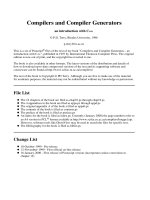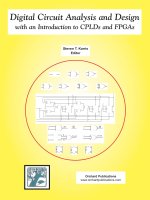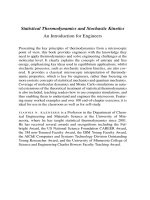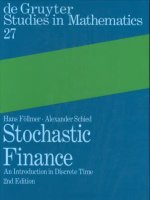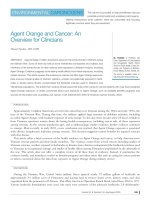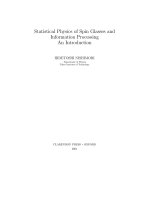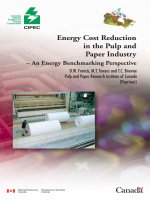Statistical Thermodynamics and Stochastic Kinetics: An Introduction for Engineers doc
Bạn đang xem bản rút gọn của tài liệu. Xem và tải ngay bản đầy đủ của tài liệu tại đây (9.15 MB, 328 trang )
Statistical Thermodynamics and Stochastic Kinetics
An Introduction for Engineers
Presenting the key principles of thermodynamics from a microscopic
point of view, this book provides engineers with the knowledge they
need to apply thermodynamics and solve engineering challenges at the
molecular level. It clearly explains the concepts of entropy and free
energy, emphasizing key ideas used in equilibrium applications, whilst
stochastic processes, such as stochastic reaction kinetics, are also cov-
ered. It provides a classical microscopic interpretation of thermody-
namic properties, which is key for engineers, rather than focusing on
more esoteric concepts of statistical mechanics and quantum mechanics.
Coverage of molecular dynamics and Monte Carlo simulations as natu-
ral extensions of the theoretical treatment of statistical thermodynamics
is also included, teaching readers how to use computer simulations, and
thus enabling them to understand and engineer the microcosm. Featur-
ing many worked examples and over 100 end-of-chapter exercises, it is
ideal for use in the classroom as well as for self-study.
yiannis n. kaznessis is a Professor in the Department of Chem-
ical Engineering and Materials Science at the University of Min-
nesota, where he has taught statistical thermodynamics since 2001.
He has received several awards and recognitions including the Ful-
bright Award, the US National Science Foundation CAREER Award,
the 3M non-Tenured Faculty Award, the IBM Young Faculty Award,
the AIChE Computers and Systems Technology Division Outstanding
Young Researcher Award, and the University of Minnesota College of
Science and Engineering Charles Bowers Faculty Teaching Award.
This is a well-rounded, innovative textbook suitable for a graduate sta-
tistical thermodynamics course, or for self-study. It is clearly written,
includes important modern topics (such as molecular simulation and
stochastic modeling methods) and has a good number of interesting
problems.
Athanassios Z. Panagiotopoulos
Princeton University
Statistical Thermodynamics and
Stochastic Kinetics
An Introduction for Engineers
YIANNIS N. KAZNESSIS
University of Minnesota
cambridge university press
Cambridge, New York, Melbourne, Madrid, Cape Town,
Singapore, S
˜
ao Paulo, Delhi, Tokyo, Mexico City
Cambridge University Press
The Edinburgh Building, Cambridge CB2 8RU, UK
Published in the United States of America by Cambridge University Press, New York
www.cambridge.org
Information on this title: www.cambridge.org/9780521765619
C
Yiannis N. Kaznessis 2012
This publication is in copyright. Subject to statutory exception
and to the provisions of relevant collective licensing agreements,
no reproduction of any part may take place without the written
permission of Cambridge University Press.
First published 2012
Printed in the United Kingdom at the University Press, Cambridge
A catalogue record for this publication is available from the British Library
Library of Congress Cataloguing in Publication data
Kaznessis, Yiannis Nikolaos, 1971 -
Statistical thermodynamics and stochastic kinetics : an introduction
for engineers / Yiannis Nikolaos Kaznessis.
p. cm.
Includes index.
ISBN 978-0-521-76561-9
1. Statistical thermodynamics. 2. Stochastic processes.
3. Molucular dynamics–Simulation methods. I. Title.
TP155.2.T45K39 2012
536
.7–dc23 2011031548
ISBN 978-0-521-76561-9 Hardback
Cambridge University Press has no responsibility for the persistence or
accuracy of URLs for external or third-party internet websites referred to
in this publication, and does not guarantee that any content on such
websites is, or will remain, accurate or appropriate.
To my beloved wife, Elaine
Contents
Acknowledgments page xiii
1 Introduction 1
1.1 Prologue 1
1.2 If we had only a single lecture in statistical thermodynamics 3
2 Elements of probability and combinatorial theory 11
2.1 Probability theory 11
2.1.1 Useful definitions 12
2.1.2 Probability distributions 13
2.1.3 Mathematical expectation 15
2.1.4 Moments of probability distributions 15
2.1.5 Gaussian probability distribution 16
2.2 Elements of combinatorial analysis 17
2.2.1 Arrangements 17
2.2.2 Permutations 18
2.2.3 Combinations 18
2.3 Distinguishable and indistinguishable particles 19
2.4 Stirling’s approximation 20
2.5 Binomial distribution 21
2.6 Multinomial distribution 23
2.7 Exponential and Poisson distributions 23
2.8 One-dimensional random walk 24
2.9 Law of large numbers 26
2.10 Central limit theorem 28
2.11 Further reading 29
2.12 Exercises 29
3 Phase spaces, from classical to quantum mechanics,
and back 32
3.1 Classical mechanics 32
3.1.1 Newtonian mechanics 32
3.1.2 Generalized coordinates 35
viii Contents
3.1.3 Lagrangian mechanics 37
3.1.4 Hamiltonian mechanics 40
3.2 Phase space 43
3.2.1 Conservative systems 46
3.3 Quantum mechanics 47
3.3.1 Particle–wave duality 49
3.3.2 Heisenberg’s uncertainty principle 58
3.4 From quantum mechanical to classical mechanical phase
spaces 60
3.4.1 Born–Oppenheimer approximation 62
3.5 Further reading 62
3.6 Exercises 63
4 Ensemble theory 66
4.1 Distribution function and probability density in phase space 66
4.2 Ensemble average of thermodynamic properties 69
4.3 Ergodic hypothesis 70
4.4 Partition function 71
4.5 Microcanonical ensemble 71
4.6 Thermodynamics from ensembles 73
4.7 S = k
B
ln , or entropy understood 75
4.8 for ideal gases 79
4.9 with quantum uncertainty 83
4.10 Liouville’s equation 86
4.11 Further reading 89
4.12 Exercises 89
5 Canonical ensemble 91
5.1 Probability density in phase space 91
5.2 NVT ensemble thermodynamics 95
5.3 Entropy of an NVT system 97
5.4 Thermodynamics of NVT ideal gases 99
5.5 Calculation of absolute partition functions is impossible and
unnecessary 103
5.6 Maxwell–Boltzmann velocity distribution 104
5.7 Further reading 107
5.8 Exercises 107
6 Fluctuations and other ensembles 110
6.1 Fluctuations and equivalence of different ensembles 110
6.2 Statistical derivation of the NVT partition function 113
6.3 Grand-canonical and isothermal-isobaric ensembles 115
6.4 Maxima and minima at equilibrium 117
Contents ix
6.5 Reversibility and the second law of thermodynamics 120
6.6 Further reading 122
6.7 Exercises 122
7 Molecules 124
7.1 Molecular degrees of freedom 124
7.2 Diatomic molecules 125
7.2.1 Rigid rotation 130
7.2.2 Vibrations included 132
7.2.3 Subatomic degrees of freedom 135
7.3 Equipartition theorem 135
7.4 Further reading 137
7.5 Exercises 137
8 Non-ideal gases 139
8.1 The virial theorem 140
8.1.1 Application of the virial theorem: equation of state
for non-ideal systems 142
8.2 Pairwise interaction potentials 144
8.2.1 Lennard-Jones potential 146
8.2.2 Electrostatic interactions 148
8.2.3 Total intermolecular potential energy 149
8.3 Virial equation of state 149
8.4 van der Waals equation of state 150
8.5 Further reading 153
8.6 Exercises 153
9 Liquids and crystals 155
9.1 Liquids 155
9.2 Molecular distributions 155
9.3 Physical interpretation of pair distribution functions 158
9.4 Thermodynamic properties from pair distribution functions 162
9.5 Solids 164
9.5.1 Heat capacity of monoatomic crystals 164
9.5.2 The Einstein model of the specific heat of crystals 167
9.5.3 The Debye model of the specific heat of crystals 169
9.6 Further reading 170
9.7 Exercises 171
10 Beyond pure, single-component systems 173
10.1 Ideal mixtures 173
10.1.1 Properties of mixing for ideal mixtures 176
10.2 Phase behavior 177
x Contents
10.2.1 The law of corresponding states 181
10.3 Regular solution theory 182
10.3.1 Binary vapor–liquid equilibria 185
10.4 Chemical reaction equilibria 186
10.5 Further reading 188
10.6 Exercises 188
11 Polymers – Brownian dynamics 190
11.1 Polymers 190
11.1.1 Macromolecular dimensions 190
11.1.2 Rubber elasticity 194
11.1.3 Dynamic models of macromolecules 196
11.2 Brownian dynamics 198
11.3 Further reading 201
11.4 Exercises 201
12 Non-equilibrium thermodynamics 202
12.1 Linear response theory 202
12.2 Time correlation functions 204
12.3 Fluctuation–dissipation theorem 208
12.4 Dielectric relaxation of polymer chains 210
12.5 Further reading 213
12.6 Exercises 214
13 Stochastic processes 215
13.1 Continuous-deterministic reaction kinetics 216
13.2 Away from the thermodynamic limit – chemical master
equation 218
13.2.1 Analytic solution of the chemical master equation 221
13.3 Derivation of the master equation for any stochastic process 225
13.3.1 Chapman–Kolmogorov equation 226
13.3.2 Master equation 227
13.3.3 Fokker–Planck equation 228
13.3.4 Langevin equation 229
13.3.5 Chemical Langevin equations 230
13.4 Further reading 231
13.5 Exercises 231
14 Molecular simulations 232
14.1 Tractable exploration of phase space 232
14.2 Computer simulations are tractable mathematics 234
14.3 Introduction to molecular simulation techniques 235
14.3.1 Construction of the molecular model 235
Contents xi
14.3.2 Semi-empirical force field potential 239
14.3.3 System size and geometry 242
14.3.4 Periodic boundary conditions 243
14.3.5 FORTRAN code for periodic boundary conditions 244
14.3.6 Minimum image convection 245
14.4 How to start a simulation 250
14.5 Non-dimensional simulation parameters 252
14.6 Neighbor lists: a time-saving trick 252
14.7 Further reading 253
14.8 Exercises 254
15 Monte Carlo simulations 255
15.1 Sampling of probability distribution functions 256
15.2 Uniformly random sampling of phase space 257
15.3 Markov chains in Monte Carlo 259
15.4 Importance sampling 262
15.4.1 How to generate states 263
15.4.2 How to accept states 264
15.4.3 Metropolis Monte Carlo pseudo-code 266
15.4.4 Importance sampling with a coin and a die 267
15.4.5 Biased Monte Carlo 268
15.5 Grand canonical Monte Carlo 268
15.6 Gibbs ensemble Monte Carlo for phase equilibria 269
15.7 Further reading 271
15.8 Exercises 272
16 Molecular dynamics simulations 273
16.1 Molecular dynamics simulation of simple fluids 274
16.2 Numerical integration algorithms 274
16.2.1 Predictor–corrector algorithms 276
16.2.2 Verlet algorithms 277
16.3 Selecting the size of the time step 279
16.4 How long to run the simulation? 280
16.5 Molecular dynamics in other ensembles 280
16.5.1 Canonical ensemble molecular dynamics simulations 282
16.6 Constrained and multiple time step dynamics 284
16.7 Further reading 285
16.8 Exercises 286
17 Properties of matter from simulation results 287
17.1 Structural properties 287
17.2 Dynamical information 289
17.2.1 Diffusion coefficient 289
xii Contents
17.2.2 Correlation functions 290
17.2.3 Time correlation functions 291
17.3 Free energy calculations 292
17.3.1 Free energy perturbation methods 292
17.3.2 Histogram methods 293
17.3.3 Thermodynamic integration methods 293
17.4 Further reading 294
17.5 Exercises 294
18 Stochastic simulations of chemical reaction kinetics 295
18.1 Stochastic simulation algorithm 296
18.2 Multiscale algorithms for chemical kinetics 297
18.2.1 Slow-discrete region (I) 299
18.2.2 Slow-continuous region (II) 299
18.2.3 Fast-discrete region (III) 299
18.2.4 Fast-continuous stochastic region (IV) 300
18.2.5 Fast-continuous deterministic region (V) 300
18.3 Hybrid algorithms 300
18.4 Hybrid stochastic algorithm 302
18.4.1 System partitioning 302
18.4.2 Propagation of the fast subsystem – chemical
Langevin equations 303
18.4.3 Propagation of the slow subsystem – jump equations 303
18.5 Hy3S – Hybrid stochastic simulations for supercomputers 304
18.6 Multikin – Multiscale kinetics 305
18.7 Further reading 305
18.8 Exercises 306
Appendices
A Physical constants and conversion factors 308
A.1 Physical constants 308
A.2 Conversion factors 308
B Elements of classical thermodynamics 309
B.1 Systems, properties, and states in thermodynamics 309
B.2 Fundamental thermodynamic relations 310
Index 312
Acknowledgments
I am grateful for the contributions that many people have made to this
book. Ed Maggin was the first to teach me Statistical Thermodynam-
ics and his class notes were always a point of reference. The late Ted
H. Davis gave me encouragement and invaluable feedback. Dan Bolin-
tineanu and Thomas Jikku read the final draft and helped me make many
corrections. Many thanks go to the students who attended my course in
Statistical Thermodynamics and who provided me with many valuable
comments regarding the structure of the book. I also wish to thank the
students in my group at Minnesota for their assistance with making
programs available on sourceforge.net. In particular, special thanks go
to Tony Hill who oversaw the development and launch of the stochastic
reaction kinetics algorithms. Finally, I am particularly thankful for the
support of my wife, Elaine.
1
Introduction
1.1 Prologue
Engineers learn early on in their careers how to harness energy from
nature, how to generate useful forms of energy, and how to transform
between different energy forms. Engineers usually first learn how to do
this in thermodynamics courses.
There are two fundamental concepts in thermodynamics, energy, E,
and entropy, S. These are taught axiomatically in engineering courses,
with the help of the two laws of thermodynamics:
(1) energy is always conserved, and
(2) the entropy difference for any change is non-negative.
Typically, the first law of thermodynamics for the energy of a system
is cast into a balance equation of the form:
change of energy in the system
between times t
1
and t
2
=
energy that entered the system
between times t
1
and t
2
−
energy that exited the system
between times t
1
and t
2
+
energy generated in the system
between times t
1
and t
2
.
(1.1)
The second law of thermodynamics for the entropy of a system can
be presented through a similar balance, with the generation term never
taking any negative values. Alternatively, the second law is presented
with an inequality for the entropy, S ≥ 0, where S is the change of
entropy of the system for a well-defined change of the system’s state.
These laws have always served engineering disciplines well. They
are adequate for purposes of engineering distillation columns, aircraft
engines, power plants, fermentation reactors, or other large, macroscopic
systems and processes. Sound engineering practice is inseparable from
understanding the first principles underlying physical phenomena and
processes, and the two laws of thermodynamics form a solid core of this
understanding.
2 Introduction
Macroscopic phenomena and processes remain at the heart of engi-
neering education, yet the astonishing recent progress in fields like
nanotechnology and genetics has shifted the focus of engineers to the
microcosm. Thermodynamics is certainly applicable at the microcosm,
but absent from the traditional engineering definitions is a molecular
interpretation of energy and entropy. Understanding thermodynamic
behavior at small scales can then be elusive.
The goal of this book is to present thermodynamics from a micro-
scopic point of view, introducing engineers to the body of knowledge
needed to apply thermodynamics and solve engineering challenges at
the molecular level. Admittedly, this knowledge has been created in
the physical and chemical sciences for more than one hundred years,
with statistical thermodynamics. There have been hundreds of books
published on this subject, since Josiah Willard Gibbs first developed
his ensemble theory in the 1880s and published the results in a book in
1902. What then could another textbook have to offer?
I am hoping primarily three benefits:
1. A microscopic interpretation of thermodynamic concepts that engi-
neers will find appropriate, one that does not dwell in the more eso-
teric concepts of statistical thermodynamics and quantum mechanics.
I should note that this book does not shy away from mathematical
derivations and proofs. I actually believe that sound mathematics is
inseparable from physical intuition. But in this book, the presentation
of mathematics is subservient to physical intuition and applicability
and not an end in itself.
2. A presentation of molecular dynamics and Monte Carlo simulations
as natural extensions of the theoretical treatment of statistical ther-
modynamics. I philosophically subscribe to the notion that computer
simulations significantly augment our natural capacity to study and
understand the natural world and that they are as useful and accu-
rate as their underlying theory. Solidly founded on the theoretical
concepts of statistical thermodynamics, computer simulations can
become a potent instrument for assisting efforts to understand and
engineer the microcosm.
3. A brief coverage of stochastic processes in general, and of stochastic
reaction kinetics in particular. Many dynamical systems of scien-
tific and technological significance are not at the thermodynamic
limit (systems with very large numbers of particles). Stochasticity
then emerges as an important feature of their dynamic behavior.
Traditional continuous-deterministic models, such as reaction rate
If we had only a single lecture in statistical thermodynamics 3
ordinary differential equations for reaction kinetics, do not capture
the probabilistic nature of small systems. I present the theory for
stochastic processes and discuss algorithmic solutions to capture
the probabilistic nature of systems away from the thermodynamic
limit.
To provide an outline of the topics discussed in the book, I present
a summary of the salient concepts of statistical thermodynamics in the
following section.
1.2 If we had only a single lecture in statistical thermodynamics
The overarching goal of classical statistical thermodynamics is to
explain thermodynamic properties of matter in terms of atoms. Briefly,
this is how:
Consider a system with N identical particles contained in volume
V with a total energy E. Assume that N , V ,andE are kept constant.
We call this an NVE system (Fig. 1.1). These parameters uniquely
define the macroscopic state of the system, that is all the rest of the
thermodynamic properties of the system are defined as functions of N ,
V ,andE. For example, we can write the entropy of the system as a
function S = S(N, V , E), or the pressure of the system as a function
P = P(N, V, E). Indeed, if we know the values of N, V ,andE for
a single-component, single-phase system, we can in principle find the
values of the enthalpy H , the Gibbs free energy G, the Helmholtz free
energy A, the chemical potential , the entropy S, the pressure P,and
the temperature T . In Appendix B, we summarize important elements
of thermodynamics, including the fundamental relations between these
properties.
Figure 1.1 System with N particles contained in volume V with a total energy E.
4 Introduction
A fundamentally important concept of statistical thermodynamics is
the microstate of a system. We define a microstate of a system by the
values of the positions and velocities of all the N particles. We can
concisely describe a microstate with a 6N -dimensional vector
X
= (r
1
, r
2
, ,r
N
,
˙
r
1
,
˙
r
2
, ,
˙
r
N
). (1.2)
In Eq. 1.2, r
i
are the three position coordinates and
˙
r
i
are the three
velocity coordinates of particle i, respectively, with i = 1, 2, ,N .
By definition,
˙
r
i
= dr
i
/dt. Note that the positions and the velocities of
atoms do not depend on one another.
An important postulate of statistical thermodynamics is that each
macroscopic property M of the system (for example the enthalpy H,or
the pressure P) at any time t is a function of the positions and veloci-
ties of the N particles at t, i.e., M(t) = M(X
(t)). Then, any observed,
experimentally measured property M
observed
is simply the time average
of instantaneous values M(t),
M
observed
=M=lim
T →∞
1
T
T
0
M(X (t))dt, (1.3)
where T is the time of the experimental measurement.
Equation (1.3) provides a bridge between the observable macroscopic
states and the microscopic states of any system. If there were a way to
know the microscopic state of the system at different times then all
thermodynamic properties could be determined. Assuming a classical
system of point-mass particles, Newtonian mechanics provides such a
way. We can write Newton’s second law for each particle i as follows:
m
i
¨
r
i
= F
i
, (1.4)
where m
i
is the mass of particle i,
¨
r
i
= d
2
r
i
/dt
2
,andF
i
is the force
vector on particle i, exerted by the rest of the particles, the system walls,
and any external force fields.
We can define the microscopic kinetic and potential energies, K and
U , respectively so that E = K +U. The kinetic energy is
K = K (
˙
r
1
,
˙
r
2
, ,
˙
r
N
) =
N
i=1
1
2
m
i
˙
r
2
i
. (1.5)
The potential energy is
U = U(r
1
, r
2
, ,r
N
), (1.6)
If we had only a single lecture in statistical thermodynamics 5
so that (for conservative systems)
F
i
=−
∂U
∂r
i
. (1.7)
Albert Einstein attempted to infer the laws of thermodynamics from
Newtonian mechanics for systems with large but finite degrees of free-
dom. In principle, a set of initial conditions at t = 0, X
(0), would suffice
to solve the second law of motion for each particle, determine X
(t)and
through Eq. (1.3) determine thermodynamic properties. Einstein was,
however, unsuccessful in his quest. A simple reason is that it is not
practically feasible to precisely determine the initial microscopic state
of a system with a large number of particles N , because it is not possible
to conduct 6N independent experiments simultaneously.
The impossibility of this task notwithstanding, even if the initial con-
ditions of a system could be precisely determined in a careful experiment
at t = 0 , the solution of 6N equations of motion in time is not possible
for large numbers of particles. Had Einstein had access to the super-
computing resources available to researchers today, he would still not
be able to integrate numerically the equations of motion for any system
size near N = 10
23
. To appreciate the impossibility of this task, assume
that a computer exists that can integrate for one time step 10 000 coupled
ordinary differential equations in one wall-clock second. This computer
would require 10
20
seconds to integrate around 10
24
equations for this
single time step. With the age of the universe being, according to NASA,
around 13.7 billion years, or around 432 ×10
15
seconds, the difficulty of
directly connecting Newtonian mechanics to thermodynamics becomes
apparent.
Thankfully, Josiah Willard Gibbs
∗
developed an ingenious conceptual
framework that connects the microscopic states of a system to macro-
scopic observables. He accomplished this with the help of the concept
of phase space (Fig. 1.2). For a system with N particles, the phase space
is a 6N dimensional space where each of the 6N orthogonal axes cor-
responds to one of the 6N degrees of freedom, i.e., the positions and
velocities of the particles. Each point in phase space is identified by a
vector
X
= (r
1
, r
2
, ,r
N
,
˙
r
1
,
˙
r
2
, ,
˙
r
N
), (1.8)
∗
It is noteworthy that Gibbs earned a Ph.D. in Engineering from Yale in 1863. Actually, his was
the first engineering doctorate degree awarded at Yale. Gibbs had studied Mathematics and
Latin as an undergraduate and stayed at Yale for all of his career as a Professor in Mathematical
Physics.
6 Introduction
or equivalently by a vector
X
= (r
1
, r
2
, ,r
N
, p
1
, p
2
, , p
N
), (1.9)
where p
i
= m
i
˙
r
i
, is the momentum of particle i.
Consequently, each point in phase space represents a microscopic
state of the system. For an NVE system the phase space is finite, since
no position axis can extend beyond the confines of volume V and no
momentum axis can extend beyond a value that yields the value of the
total kinetic energy.
In classical mechanics the phase space is finite, of size , but because
it is continuous, the number of microscopic states is infinite. For each
state identified with a point X
, a different state can be defined at X +dX,
where dX
is an infinitesimally small distance in 6N dimensions.
Thanks to quantum mechanics, we now know that this picture of a
continuous phase space is physically unattainable. Werner Heisenberg’s
uncertainty principle states that the position and momentum of a par-
ticle cannot be simultaneously determined with infinite precision. For
a particle confined in one dimension, the uncertainties in the position,
x, and momentum, p, cannot vary independently: xp ≥ h/4,
where h = 6.626 × 10
−34
m
2
kg/s is Planck’s constant.
The implication for statistical mechanics is significant. What the
quantum mechanical uncertainty principle does is simply to discretize
the phase space (Fig. 1.3). For any NVE system, instead of an infinite
number of possible microscopic states, there is a finite number of micro-
scopic states corresponding to the macroscopic NVE system. Let us
call this number and write (N, V, E) to denote that it is determined
by the macroscopic state.
Figure 1.2 Phase space . Each microscopic state of a macroscopic NVE system
is represented by a single point in 6N dimensions.
p
1
q
1
p
3N
q
3N
Γ
X
If we had only a single lecture in statistical thermodynamics 7
Another fundamental postulate of statistical thermodynamics is that
all these microscopic states have the same probability of occurring.
This probability is then
P = 1/. (1.10)
Ludwig Boltzmann showed around the same time as Gibbs that the
entropy of an NVE system is directly related to the number of micro-
scopic states . Gibbs and Boltzmann were thus able to provide a direct
link between microscopic and macroscopic thermodynamics, one that
proved to be also useful and applicable. The relation between entropy
S(N, V, E) and the number of microscopic states (N, V , E) has been
determined by numerous different methods. We will present a concise
one that Einstein proposed:
1. Assume there generally exists a specific function that relates the
entropy of an NVE system to the number of microscopic states
that correspond to this NVE macroscopic state. The relation can be
written as
S = (). (1.11)
2. Consider two independent systems A and B.Then
S
A
= (
A
), (1.12)
and
S
B
= (
B
). (1.13)
3. Consider the composite system of A and B.CallitsystemAB.
Since entropy is an extensive property, the entropy of the composite
system is
S
AB
= (
AB
) = S
A
+ S
B
= (
A
) + (
B
). (1.14)
Figure 1.3 The available phase space to any macroscopic state is an ensemble of
discrete microscopic states. The size of the available phase space is ,andthe
number of microscopic states is .
p
1
q
1
p
3N
q
3N
Σ
Ω
8 Introduction
4. Since the systems are independent, the probability of the composite
system being in a particular microscopic state is equal to the
product of probabilities that systems A and B are in their respective
particular microscopic state, i.e.,
P
AB
= P
A
P
B
. (1.15)
Therefore the number of microscopic states of the composite system
can be written as
AB
=
A
B
. (1.16)
5. Combining the results in the two previous steps,
(
AB
) = (
A
B
) = (
A
) + (
B
). (1.17)
The solution of this equation is
() = k
B
ln(), (1.18)
and thus
S = k
B
ln(), (1.19)
where k
B
= 1.38065 ×10
−23
m
2
kg s
−2
K
−1
is Boltzmann’s constant.
This equation, which is called Boltzmann’s equation, provides a direct
connection between microscopic and macroscopic properties of matter.
Importantly, the entropy of NVE systems is defined in a way that
provides a clear physical interpretation.
Looking at the phase space not as a succession in time of microscopic
states that follow Newtonian mechanics, but as an ensemble of micro-
scopic states with probabilities that depend on the macroscopic state,
Gibbs and Boltzmann set the foundation of statistical thermodynamics,
which provides a direct connection between classical thermodynamics
and microscopic properties.
This has been accomplished not only for NVE systems, but for
NVT, NPT,andVT systems among others. Indeed, for any system
in an equilibrium macroscopic state, statistical thermodynamics focuses
on the determination of the probabilities of all the microscopic states
that correspond to the equilibrium macrostate. It also focuses on the
enumeration of these microscopic states. With the information of how
many microscopic states correspond to a macroscopic one and of what
their probabilities are, the thermodynamic state and behavior of the
system can be completely determined.
If we had only a single lecture in statistical thermodynamics 9
Remembering from thermodynamics that
dE = TdS− PdV +dN, (1.20)
we can write, for the NVE system
∂ S
∂ E
N,V
=
1
T
, (1.21)
or
∂ ln()
∂ E
N,V
=
1
k
B
T
. (1.22)
Similarly,
∂ ln()
∂V
N,E
=
P
k
B
T
, (1.23)
and
∂ ln()
∂ N
E,V
=−
k
B
T
. (1.24)
In this book I present the theory for enumerating the microscopic
states of equilibrium systems and determining their probabilities. I
then discuss how to use this knowledge to derive thermodynamic
properties, using Eqs. 1.21–1.24, or other similar ones for different
ensembles.
As an example, consider an ideal gas of N particles, in volume V ,
with energy E. The position of any of these non-interacting particles is
independent of the positions of the rest of the particles. We discuss in
Chapter 4 that in this case we can enumerate the microscopic states. In
fact we find that
(N, V, E) ∝ V
N
. (1.25)
Using Eq. 1.23 we can then write
P
k
B
T
=
N
V
, (1.26)
and rearranging
PV = Nk
B
T. (1.27)
We can show that the Boltzmann constant is equal to the ratio of the
ideal gas constant over the Avogadro number, k
B
= R/N
A
. Then for
10 Introduction
ideal gases
PV = nRT, (1.28)
where n is the number of moles of particles in the system.
First stated by Beno
ˆ
ıt Paul Emile Clapeyron in 1834, the ideal gas
law, an extraordinary and remarkably simple equation that has since
guided understanding of gas thermodynamics, was originally derived
empirically. With statistical thermodynamics the ideal gas law is derived
theoretically from simple first principles and statistical arguments.
I discuss how other equations of state can be derived theoretically
using information about the interactions at the atomic level. I do this
analytically for non-ideal gases, liquids, and solids of single compo-
nents of monoatomic and of diatomic molecules. I then introduce com-
puter simulation techniques that enable us numerically to connect the
microcosm with the macrocosm for more complex systems, for which
analytical solutions are intractable.
In Chapter 2, I present the necessary elements of probability and com-
binatorial theory to enumerate microscopic states and determine their
probability. I assume no prior exposure to statistics, which is regretfully
true for most engineers.
I then discuss, in Chapter 3, the classical mechanical concepts
required to define microscopic states. I introduce quantum mechan-
ics in order to discuss the notion of a discrete phase space. In Chapter 4,
I introduce the classical ensemble theory, placing emphasis on the NVE
ensemble.
In Chapter 5, I define the canonical NVT ensemble. In Chapter 6, fluc-
tuations and the equivalence of various ensembles is presented. Along
the way, we derive the thermodynamic properties of monoatomic ideal
gases.
Diatomic gases, non-ideal gases, liquids, crystals, mixtures, reacting
systems, and polymers are discussed in Chapters 7–11.
I present an introduction to non-equilibrium thermodynamics in
Chapter 12, and stochastic processes in Chapter 13.
Finally, in Chapters 14–18, I introduce elements of Monte Carlo,
molecular dynamics and stochastic kinetic simulations, presenting them
as the natural, numerical extension of statistical mechanical theories.
2
Elements of probability and combinatorial theory
ariqmw de ta panta epeoiken
Pythagoras (570–495 BC)
2.1 Probability theory
There are experiments with more than one outcome for any trial. If
we do not know which outcome will result in a given trial, we define
outcomes as random and we assign a number to each outcome, called
the probability. We present two distinct definitions of probability:
1. Classical probability. Given W possible simple outcomes to an
experiment or measurement, the classical probability of a simple
event E
i
is defined as
P(E
i
) = 1/W. (2.1)
Example 2.1
If the experiment is tossing a coin, there are W = 2 possible outcomes:
E
1
= “heads,” E
2
= “tails.” The probability of each outcome is
P(E
i
) = 1/2. i = 1, 2 (2.2)
2. Statistical probability. If an experiment is conducted N times and
an event E
i
occurs n
i
times (n
i
≤ N ), the statistical probability of
this event is
P(E
i
) = lim
N →∞
n
i
N
. (2.3)
The statistical probability converges to the classical probability when
the number of trials is infinite. If the number of trials is small, then
the value of the statistical probability fluctuates. We show later in this
chapter that the magnitude of fluctuations in the value of P(E
i
)is
inversely proportional to
√
N .
